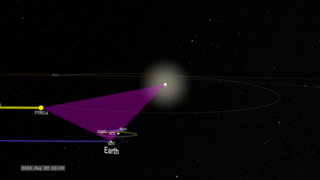Sun
ID: 3809
When the two STEREO spacecraft move into positions on opposite sides of the Sun, we will have the capability to see a full 360 degrees around the solar sphere (there will probably still be some gaps in visibility near the poles of the Sun). Combined with solar observing satellites near the Earth, such as SDO and SOHO, this coverage will last for about eight years and the STEREO spacecraft move along in their orbits.
STEREO Achieves Full Solar Coverage: All the Sun. All the Time
This movie illustrates the orbital motions of the two STEREO spacecraft relative to the Earth (and noting the positions of the planets Mercury & Venus for reference). The camera occupies a position fixed relative to the Earth and Sun, so the distant starfield appears to spin around the observer.
Because the frames are sampled at one per solar day, the Earth does not appear to rotate, but patient observation reveals that the tilt of the planet relative to the Sun, varies throughout the year, with the northern hemisphere tilted towards the Sun in northern hemisphere summer and away from the Sun in northern hemisphere winter.
Related
Visualization Credits
Tom Bridgman (Global Science and Technology, Inc.): Lead Animator
Scott Wiessinger (UMBC): Producer
Joe Gurman (NASA/GSFC): Scientist
Therese Kucera (NASA/GSFC): Scientist
William T. Thompson (ADNET): Scientist
Scott Wiessinger (UMBC): Producer
Joe Gurman (NASA/GSFC): Scientist
Therese Kucera (NASA/GSFC): Scientist
William T. Thompson (ADNET): Scientist
Please give credit for this item to:
NASA/Goddard Space Flight Center Scientific Visualization Studio
NASA/Goddard Space Flight Center Scientific Visualization Studio
Short URL to share this page:
https://svs.gsfc.nasa.gov/3809
Missions:
SDO
SOHO
STEREO
Data Used:
Note: While we identify the data sets used in these visualizations, we do not store any further details nor the data sets themselves on our site.
This item is part of this series:
Sun 360
Keywords:
SVS >> HDTV
SVS >> STEREO
NASA Science >> Sun
SVS >> Extreme Ultraviolet Imaging
SVS >> EUV Imaging
https://svs.gsfc.nasa.gov/3809
Missions:
SDO
SOHO
STEREO
Data Used:
SDO/AIA/304 Filter also referred to as: AIA 304
JOINT SCIENCE OPERATIONS CENTERSTEREO/Extreme UltraViolet Imager (EUVI)/304 Angstroms
SOHO/Extreme-UV Imaging Telescope (EIT)/304 Filter also referred to as: SOHO/EIT 304
NASA and ESAThis item is part of this series:
Sun 360
Keywords:
SVS >> HDTV
SVS >> STEREO
NASA Science >> Sun
SVS >> Extreme Ultraviolet Imaging
SVS >> EUV Imaging












